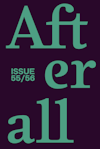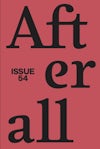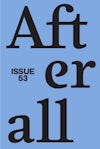
Issue 42
Autumn/Winter 2016
Issue 42 of Afterall journal looks at art as a tool for social transformation. With essays on Tania Bruguera, the Chiang Mai Social Installation, Jo Spence, Arahamaiani, Abbas Akhavan, and more.
Editors: Helena Vilalta, Anders Kreuger, David Morris, Stephanie Smith, Charles Stankievech, Deirdre O’Dwyer.
Founding editors: Charles Esche, Mark Lewis.
Table of contents
Foreword
Contextual Essays
- Images Without Bodies: Chiang Mai Social Installation and the Art History of Cooperative Suffering – Simon Soon
- The Kabakov Effect: ‘Moscow Conceptualism’ in the History of Contemporary Art
- Not Now: A Conversation with Walter Benjamin – David Morris
- CounterIntelligence: A Glossary of Doubled Agency – Charles Stankievech
Artists
Arahmaiani
- The Premise of Contradiction and Feminist Politics: Reflections on Arahmaiani’s Art and Life – Angela Dimitrakaki
- Arahmaiani: Challenging the Status Quo – Wulan Dirgantoro
Tania Bruguera
- How to Make Art with a Jackhammer: A Conversation with Tania Bruguera – W.J.T. Mitchell
- Social Autonomy and the Use Value of Art – John Byrne
Inji Efflatoun
- Public/Private: The Many Lives of ‘Rebel Painter’ Inji Efflatoun – Kaelen Wilson-Goldie
- Inji Efflatoun: White Light – Anneka Lenssen
Events, Works, Exhibitions
- The Kind of Pictures She Would Have Taken: Jo Spence – Anne Boyer
- The Gely Korzhev Retrospective in Moscow: Why Him? Why Now? – Anders Kreuger
- The Body in Ruins: Abbas Akhavan’s Study for a Monument – Georgina Jackson
- Empty Fields and Crying Stones – Helena Vilalta
Foreword
Recently a group of artists, academics, curators and activists gathered in the north of England at the Middlesbrough Institute of Modern Art (mima) to discuss the possible futures of Arte Útil. A concept and set of working practices initiated by the artist Tania Bruguera, Arte Útil proposes that art can be directly useful as a tool for social and political change. One moment from this summit feels especially relevant to this issue of Afterall. It occurred during a discussion of the Arte Útil archive, itself an evolving compendium of global projects that fall within the concept’s rubric. To date, the archive has taken various forms, from an online database to physical presentations within museum exhibitions – fairly effective ways to convey the purpose and potential of Arte Útil to a dispersed audience, but nonetheless fraught. Unlike other forms of art, even other forms of socially engaged or political art, Arte Útil is always meant to move beyond the realm of the symbolic and into the space of action. This, of course, poses an explicit challenge to the inherited conventions of art institutions. Addressing this, at one point mima director Alistair Hudson noted that ‘whenever the Arte Útil archive becomes a display mechanism or orthodoxy it dies. We lose the argument.’
This tension, between art’s established modes of engagement and an impetus towards alternative forms of action, appears repeatedly across the coming pages. Walter Benjamin, in conversation with David Morris, goes so far as to claim that ‘art’, as we know it, is obsolete, which chimes with Bruguera’s emphasis on social transformation over more traditional artistic concerns. In a wide-ranging conversation with W.J.T. Mitchell, Bruguera discusses the development of Arte Útil; and John Byrne offers an astute analysis of the broader movement around it, from grass-roots community organising to international art museums, and the issues Arte Útil must grapple with as it continues to evolve.
Many texts in this issue address the possibilities and limits of cultural institutions – museums, libraries, archives – as imperfect stewards for conflicted objects and charged histories. They are places that preserve and dismantle, conceal and reveal. Structured in the form of an associational glossary, Charles Stankievech’s account of counterintelligence touches upon the agency of objects, the ways that they can hide and be hidden within various forms of camouflage, including the cover provided by institutional norms. Helena Vilalta’s nuanced assessment of the recent exhibition ‘Empty Fields’ at SALT Galata, Istanbul addresses archival procedures as having the potential for a kind of heroism, where archival gestures offer a means to preserve vulnerable cultures during times of conflict. Sometimes conflict wins out, preservation is effaced.
Purchase
The publication is available for purchase. If you would like specific articles only, it is also available individually and to be downloaded as PDFs.
Purchase full publication
Buy via University of Chicago Press
Buy via Central Books
Purchase individual articles
Buy via University of Chicago Press







